Healing with mineral waters
Places, objects and written sources in Roman Italy
Maddalena Bassani
Abstract

1 | Sciacca (AG), plan of the Kronio’s Grottoes (Maggi 1976-1977, tav. LXVIII).
Man’s exploitation of natural thermalism has very ancient origins and has affected the history of settlements in the Mediterranean area where hot or cold but highly mineralised springs flowed, whether in the plains, on the hills, or at high altitudes (synthesis in Annibaletto, Bassani, Ghedini 2014; Matilla Séiquer, González 2017; Pérex Agorreta, Miró i Alaix 2018; Bassani, Bolder-Boos, Fusco 2019; González Soutelo forthcoming). Thanks to specific research insights, it was possible to examine archaeological, topographical, historical-epigraphic and literary data, without excluding the analysis of the natural and cultural environment in which thermalism developed over time. Depending on the epochs and building capacities, man left multiple traces of frequentation of the springs: either through sacred deposits and ex-voto to thank the deities for recovered health or to request it, or by means of very complex and articulated buildings where to practice therapy or to reside during the cures, or through literary or epigraphic texts to emphasise experience and knowledge of the aquae. Finally, equally important traces are obtained from intangible sources such as legends and oral traditions, which were entrusted with the memory of mythical figures who had discovered and enhanced the use of thermo-mineral water for individual and collective well-being. Apollo, the Nymphs, Heracles, Minerva, the Aquae, the Fontes, sometimes Asclepius, and other deities are evoked in ancient texts as patrons of springs and as healers from diseases thanks to those special waters: treatments could take place through bathing in pools, or through drinking, steam baths, inhalations, and mud baths.
This, of course, does not exclude that other ‘traditional’ treatments were planned and practiced by the physicians working in the healing stations, but this can only be plausible from the late Republican and early Empire ages: it is only from this phase that thermo-mineral therapy spread widely thanks to the indications of the methodical school and internationally renowned physicians, such as Asclepiades of Prusa, Celsus, Galen, up to Soranus of Ephesus and Oribasius of Pergamum, the latter of whom lived in the late period (most recently Zanetti 2014; Rizzi 2014).
If in fact it is the late Hellenistic and Roman culture that recognised the efficacy of mineral waters for the treatment of a variety of pathologies depending on their organoleptic characteristics, now scientifically defined (Bassani A. 2014), Roman engineering should be credited with the ability to make the most out of the therapeutic potential of the waters and the consequent income from the surrounding satellite activities (think of the proliferation of hospitia and hospitalia, stationes and mansiones along the roads that led to the establishments, but also of the residential villas and productive buildings serving the Roman spas: Ghedini 2014; Medri 2016).
Earlier, i.e. in the pre-protohistoric and archaic ages, structural data are scarce, whereas there are multiple mobile artifacts at mineral springs, where humans had direct experience on themselves and their kindred, including animals, of how aquae, vapours, and mud could solve mild or serious pathological states.
Therefore, it may be interesting to examine the traces of these frequentations not only within the large and articulated healing resorts of the Imperial age that arose close to the main thermo-mineral basins, but also in sparsely built environmental contexts, such as the caves and natural recesses of the earliest phases. Anthro-therapy, after all, has remained to this day one of the possibilities of using natural thermalism.
The Kronio Grottoes, Sicily
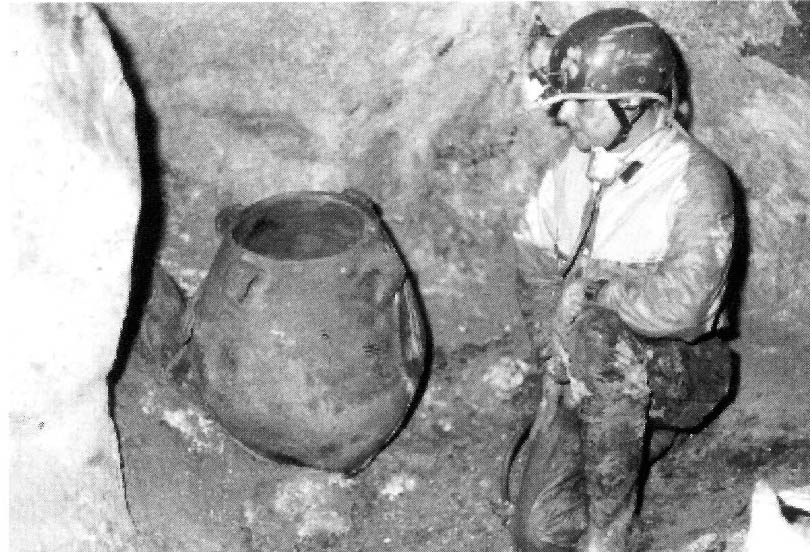
2 | Sciacca (AG), the discovery of an intact prehistoric vase in the tunnels of the Kronio’s Grottoes (Verde 2000, p. 13, fig. 1).
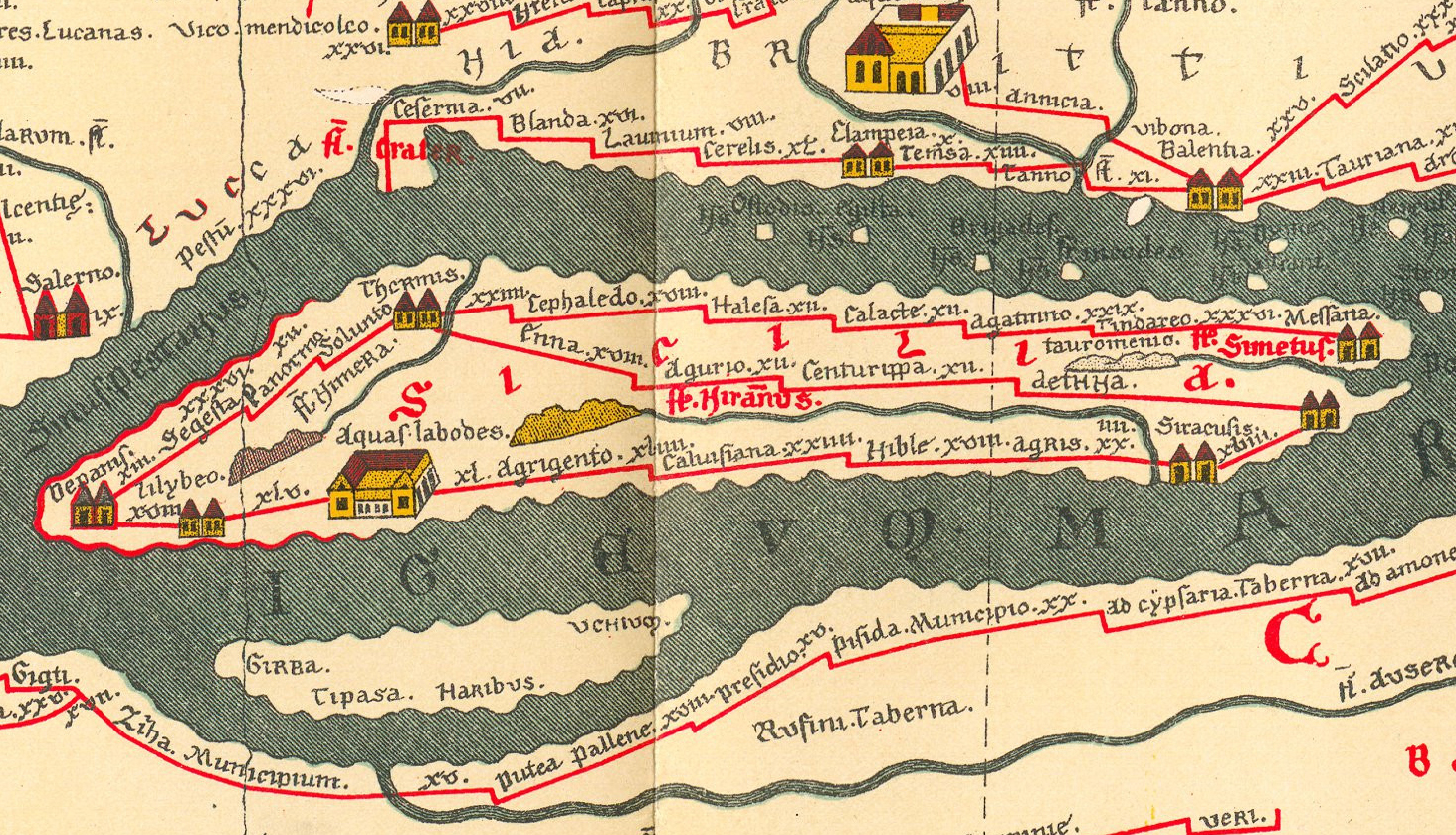
3 | Sicily in the Tabula Peutingeriana, segments VI-VII (Omnes Viae).
Early human awareness of the healing potential of mineral springs is documented at some Italian sites as far back as the Neolithic age. Exemplary is the case of Mount Kronio near Sciacca (AG), Sicily, where there is a series of natural caves extending for more than 3 km on the southern slope facing the sea, from which hot air escapes (Verde 2000; Tiné, Torelli 2013; Gullì 2014). Among them are the Daedalus cave [Fig. 1], so called because the myth attributes to the Greek inventor the construction of a therma connected to the palace of King Cocalus; the cave of the Animals, which was traditionally for ‘veterinary’ use; the cave known as the ‘Ear Hole’ for the treatment of deafness; and again the cave of the Fig and the cave of the Nobildonna (Gentlewoman), as well as the Leper’s Cave, the Stoves of San Calogero etc. The average temperature in the caverns is around 37°-39°C and therefore the environmental conditions are not at all favorable: humidity prevents one from staying longer than 40 minutes, after which one can collapse due to the rapid loss of sweat and the onset of a ‘heat stroke’.
With respect to the hot air in the caves, several springs along the lower part of Mount Kronio gush out, flanked by catchment wells: the latter are now widely exploited in the Sciacca thermal baths and are classified as salso-bromo-iodine, sulfurous and hyperthermal, ranging from 32° to 56°C.
Despite the adversity of the location, the constant presence of hot air from inside the caves must have attracted the curiosity of prehistoric men, who, if they certainly did not settle here to live, left objects in those recesses, testifying to a kind of cult and devotion to the waters and vapours that could help them heal simple or complex ailments. In fact, during speleological surveys carried out in the 20th century, 40 large vessels dated between the 6th and 3rd millennia BC were found inside some of the caves [Fig. 2], which were intentionally brought there for votive purposes. Speleological inspections have shown that only the acknowledged healing effectiveness of that natural resource could have driven prehistoric man to such great risks, and therefore it is not surprising that a very rich series of legends and myths developed around the Kronio springs, codified in Greek and then Roman times.
According to Diodorus Siculus, for example, the mythical architect-sculptor Daedalus took refuge with King Cocalus in Sicily to escape Minos, Pasiphae’s husband, and there:
τρίτον δὲ σπήλαιον κατὰ τὴν Σελινουντίαν χώραν κατεσκεύασεν, ἐν ᾧ τὴν ἀτμίδα τοῦ κατ᾽ αὐτὴν πυρὸς οὕτως εὐστόχως ἐξέλαβεν ὥστε διὰ τὴν μαλακότητα τῆς θερμασίας ἐξιδροῦν λεληθότως καὶ κατὰ μικρὸν τοὺς ἐνδιατρίβοντας καὶ μετὰ τέρψεως θεραπεύειν τὰ σώματα μηδὲν παρενοχλουμένους ὑπὸ τῆς θερμότητος (Diod. IV, 78, 3).
He built on the Selinuntine beach a cavern from which smoke evaporated from the fire so that, to those who entered, sweat was caused by the effect of heat, so that the bodies were cured with a certain voluptuousness, without at all feeling any molestation (Diod. IV, 78, 3).
The evidence, although reported by a Greek author of the 1st century BC, is of great importance because it traces knowledge of the therapeutic efficacy of the hot vapours given off by thermo-mineral waters back to prehistoric times, with a relevant continuity from the Archaic age onwards.
If in fact the mythical beaches of Selinunte coincide with the area of Sciacca and Mount Kronio a few kilometers to the southeast, the legend about the building activity of Daedalus is indicative of a very ancient frequentation of those caves, in which, thanks to the talent of the most famous ancient inventor, the precious hot steam was channeled into a kind of therma, which allowed King Cocalus and his subjects to be able to cure themselves “without feeling any molestation”. Diodorus evidently well knew the therapeutic potential of natural thermalism since he was writing in the 1st century BC, when it had by then entered full-fledged medical practice: not only through baths in pools and tubs within establishments for hundreds of people, but also through steam baths, of which those at Baia were among the most famous (Medri 2013).
It should also be mentioned that in his time thermal facilities located on the slopes of Kronius must have been functioning, using the thermo-mineral waters that still exist today. These were the Aquae Labodes, of which no archaeological remains are known but which are mentioned in the itinerary sources [Fig. 3]: in the Tabula Peutingeriana they are depicted as an enclosed quadrangular building characterised by two gabled towers, in accordance with one of the agreed symbols used in this extraordinary ancient street directory to depict such buildings. The Aquae Labodes were in fact located on the coastal road and were considered one of the most attractive tourist destinations on the southern Sicilian coast (Caminneci 2014).
Thermo-mineral waters and vapours at Mount Kronio were therefore exploited over the centuries for curative purposes, and it is no coincidence that in addition to the prehistoric deposits inside the caves other votive offerings, such as statuettes, coins, and amphorae, dated with certainty from the Archaic to the Classical and Hellenistic ages, have been found. Moreover, traces of building and infrastructural works to enable the caves to be frequented for therapeutic purposes coincide with a floor of terracotta slabs dated between the 3rd and 1st centuries BC, which extended from the so-called Antro degli Animali to the Antro di Dedalo (this information is contained in an unpublished typescript by J. Schneider, D. Caporusso dated 1987 and published by Guidi, Verde 2001, 92; further information in Mannoni 1975, 389-392).
In the same context at the end of the 4th century AD a separation wall was erected between the two caves, while during the 5th century AD seats were equipped, carving the rock of the walls of the same Antro di Dedalo, perhaps among the most striking and accessible ravines of the Sicilian mountain. It is here, moreover, that tradition has St Calogero, the “handsome old man” who cured the body and spirit and who in the 6th century AD resided in the so-called Grotta del Santo: here he is said to have performed some miracles by driving out pagan demons and evil spirits to encourage people’s use of the healing waters. He took action himself to create spa constructions, and indeed recent archaeological excavations have revealed hot steam channeling works referable to the early Medieval age, thus showing a simple but constant continuation of the frequentation of the Kronio caves through the millennia to practice the so-called anthro-therapy.
What remains today of this long medical tradition? The contemporary thermal baths in Sciacca are located downstream from the mountain, in a slightly detached position, while the huge hotel dedicated to St Calogero, which was built overhanging the Kronio in the 1950s and restored several times, has never been opened due to design flaws: it seems the connections to the city sewers were missing, at least according to newspaper reports. Sweat therapies were supposed to have been practiced here in memory of ancient customs proven over millennia, simultaneously housing, in eighty rooms spread over three floors, hundreds of people who, thanks to an elevator, could then descend into the underground stoves and heal themselves effortlessly, as Diodorus put it. Unfortunately, the structure is dilapidated and in complete disrepair, but one hopes that a new Daedalus will come up with a plan that may live up to the history and healing potential of the Kronian waters.
From the grottoes to the thermo-mineral buildings: the Aquae Cutiliae in northern Latium
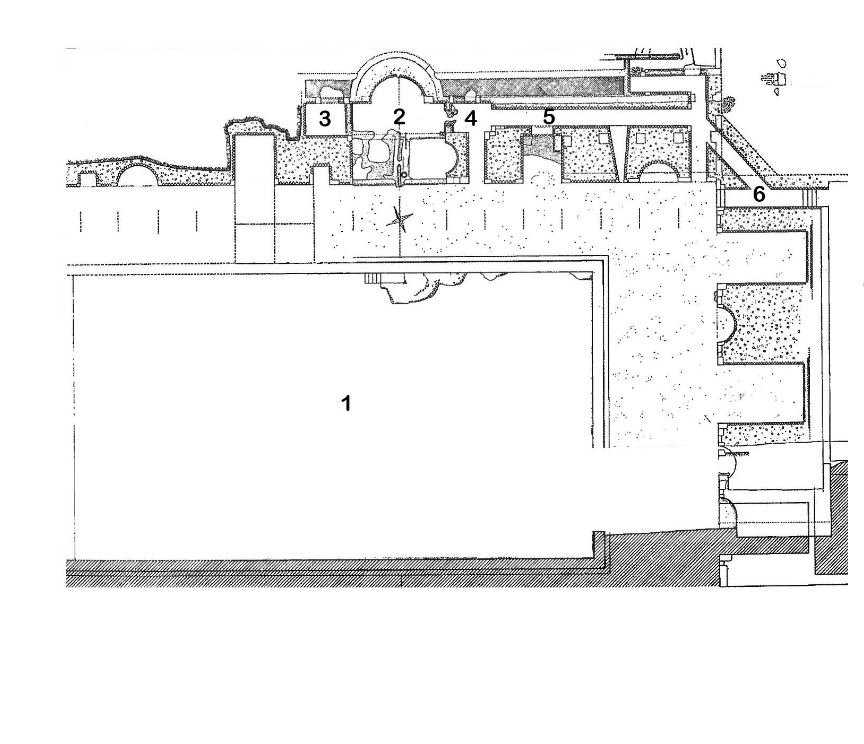
4 | Cittaducale (RI), plan of the Aquae Cutiliae thermal building (Sapelli Ragni, Mari 2011, 286).
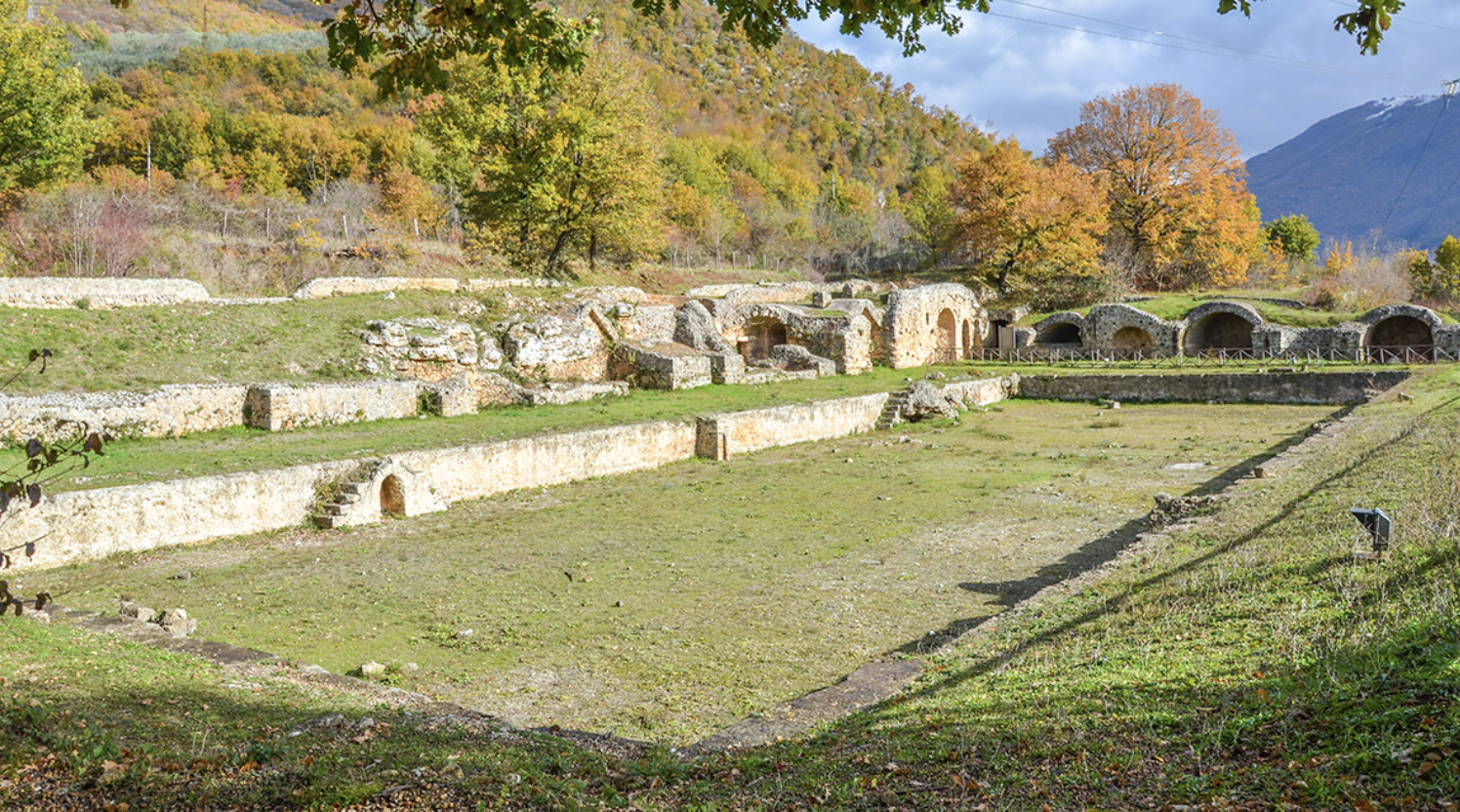
5 | Cittaducale (RI), view of the large pool of the Aquae Cutiliae (photo by Author, 2012) (By permission of the Ministry of Culture – Soprintendenza Archeologia, Belle Arti e Paesaggio per l’area metropolitana di Venezia e le province di Belluno, Padova e Treviso – Reproduction forbidden).
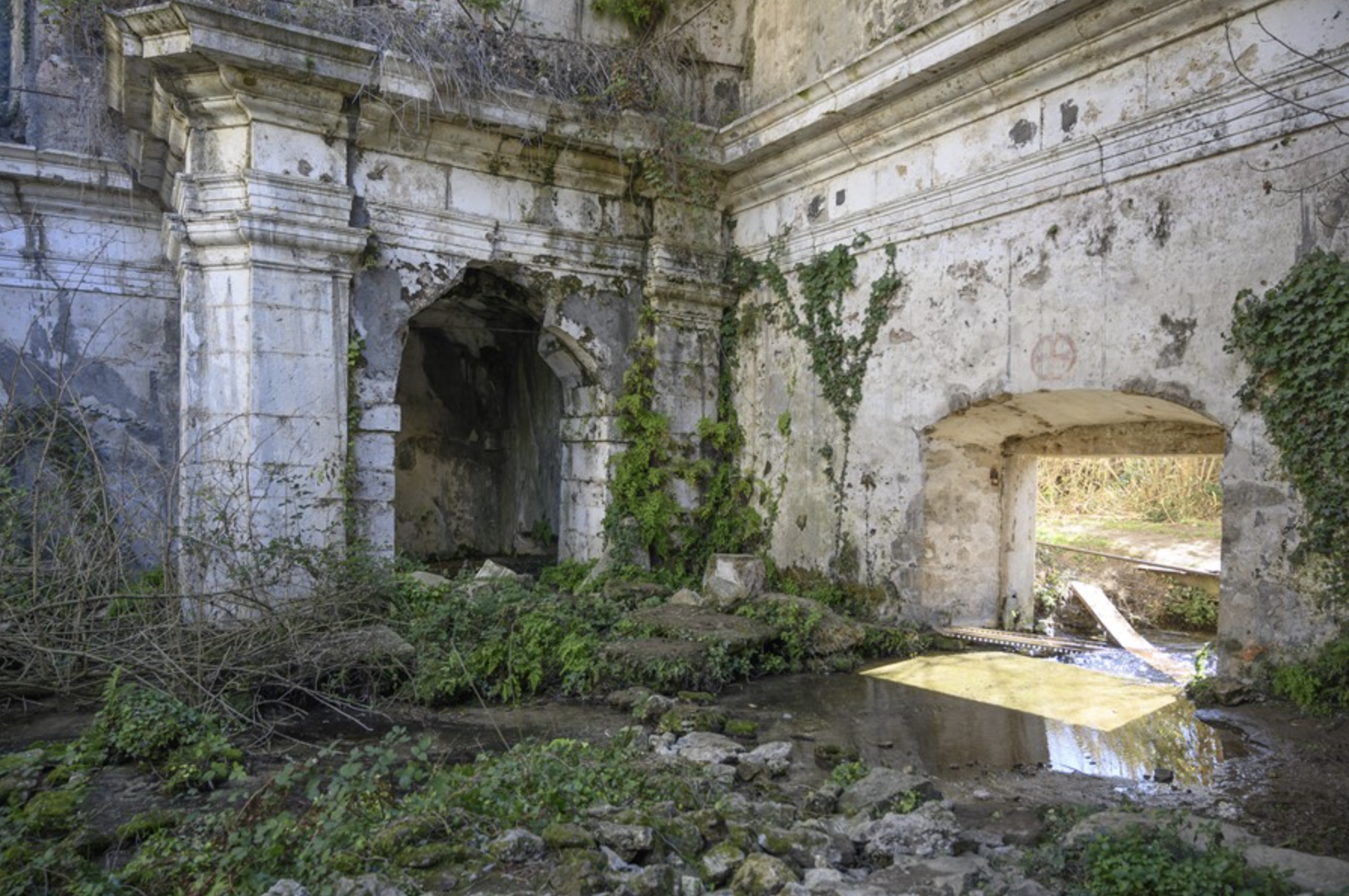
6 | Cittaducale (RI), interior of the church of St Victor (©wikicommons).
The Sicilian example described above not only illustrates a primordial, as well as effective, form of natural thermalism, but also allows us to broaden our gaze to other situations, in which archaeological and written sources attest to curative practices within building complexes articulated by means of water, steam and mud by a very large number of people from different social backgrounds.
In the Italian territories where the census was carried out, basically four types of settlements emerged, which can be in turn divided into four large macro-settlements, which could develop where there were springs with relevant and constant water flow, in order to ensure a stable supply of the natural resource, as it still happens today (Annibaletto, Basso 2014). Places of a predominantly cultic and sacral nature are attested, either provided with a sacred building or only indicated by votive deposits (Bassani 2014a and Bassani 2014b; in this issue, see articles by Jean Turfa and Jacopo Tabolli et alii); medium and large-scale health resorts (Annibaletto 2014), as well as private villas with mineral springs, or hotels and hospitia for travelers and tourists (see, for example, Bassani 2017; on the phenomenon of stationes, see Basso, Fanini 2016). Finally, production facilities are attested through the by-products of mineral waters (clay, salt concretions, mineral extracts, the motor power of the springs etc.), which allowed the development of economic and commercial activities partly intended to cater for the patients, partly designed for a wider market (Bassani 2016; Bassani 2021). We will dwell on an example of a public therapeutic station, in order to derive data about the cures practiced there and the health and economic benefits associated with them.
These are the Aquae Cutiliae in the province of Rieti, where the cold hydrogen-sulfide-bicarbonate-sulfate-alkaline springs were well known to Vitruvius, Strabo, Macrobius, Pliny the Elder and Celsus and other ancient writers (Rizzi 2014; on the facility see Sapelli Ragni, Mari 2011, esp. 286-287; Alvino 2009, esp. 98-99, who interprets the construction as a terraced sanctuary complex). By the 2nd century BC they were channeled into a huge structure centered on an open-air pool (60x24m), dug into the rock and lined with travertine slabs and built by means of the opus incertum. Numerous rooms were prepared around the pool, including rooms for resting, preparatory or post-bathing treatments, as well as changing rooms used by patients, who attended the baths over time [Fig. 4].
The grand facility was accessible from the Via Salaria and was articulated in three terraces extending for about 300m, in which the large pool occupied the second terrace; here a monumental northern façade with rectangular niches, with a nymphaeum behind, and other rooms were placed in connection with the lower and upper floors, attested by corridors and service stairs. Other areas only partially investigated were extended in the other two terraces, but the settlement around the establishment must have been capillary to ensure logistical assistance to the many tourists who came there for centuries.
Strabo informs us on the healing treatments: either taking partial baths inside the large pool while sitting, or staying in the surrounding rooms practicing hydro-pinic therapy:
Σαβῖνοι … πόλεις δ᾽ ἔχουσιν ὀλίγας καὶ τεταπεινωμένας διὰ τοὺς συνεχεῖς πολέμους, Ἀμίτερνον καὶ Ῥεᾶτε, ᾧ πλησιάζει κώμη Ἰντεροκρέα καὶ τὰ ἐν Κωτιλίαις ψυχρὰ ὕδατα, ἀφ᾽ ὧν καὶ πίνουσι καὶ ἐγκαθίζοντες θεραπεύονται νόσους (Strabo V 3, 1).
The Sabines … possess some small towns ruined by continual wars, such as Amiterno and Reate, near which is Interocrea and the icy springs of Cotilia, whose waters are not only drunk, but are employed to cure diseases, by sitting in them (Strabo V 3, 1).
In fact, those who wished to enter the pool could make use of some masonry stairs still visible today on the long sides of the pool, the depth of the basin being less than a meter [Fig. 5]: they could remain in it standing or sitting on wooden (or other material) seats for a short time, since the water averaged less than 15°C. Other patients could have been housed in the rooms facing all around the pool, but we do not know whether other pools provided bathing at other temperatures by heating with praefurnia, if we suppose them to have been in the disappeared floors or other pavilions of the establishment.
Attendance was varied and long-lasting, up to the mid-4th century AD, and counted illustrious people, even of the highest rank. We know from Suetonius (Vesp. 24) that the emperor Vespasian used to come there every summer on holiday, staying at his villa, which is perhaps to be recognised in the residence of the Aurelii Cottae in the locality of Ortali. During his ninth consulship, because persistent fevers had debilitated him while he was in Campania, he decided to travel hastily to Cutiliae to regain his strength, but he found death there:
Consulatu suo nono temptatus in Campania motiunculis levibus protinusque urbe repetita, Cutilias ac Reatina rura, ubi aestivare quotannis solebat, petit. Hic cum super urgentem valitudinem creberrimo frigidae aquae usus etiam intestina vitiasset, nec eo minus muneribus imperatoriis ex consuetudine fungeretur, ut etiam legationes audiret cubans, alvo repente usque ad defectionem soluta, “imperatorem”, ait “stantem mori oportere”; dumque consurgit ac nititur, inter manus sublevantium extinctus est VIIII. Kal. Iul. annum agens aetatis sexagensimum ac nonum superque mensem ac diem septimum (Svet. Vesp. 24).
Here, to aggravate the illness was still added indigestion, from drinking an excessive amount of ice water; nevertheless, he continued to perform, according to his custom, his duties as emperor, even receiving delegations while in bed, until, feeling himself dying from a sudden attack of diarrhea, he said, ‘An emperor must die standing up!’ and as he made an effort to rise, he expired in the arms of those who were helping him, on the ninth day before the kalends of July, at sixty-eight years, one month and six days (Svet. Vesp. 24).
Vespasian therefore died on June 23, 79 AD precisely at the Baths of Cutiliae due to the ingestion of excessive amounts of mineral water; it is possible that in a picture of general debilitation the prolonged, low-temperature intake adversely affected the emperor’s balance, but it is nonetheless true that then as now mineral water therapy had to be guided by medical personnel, and its improper application could prove fatal. A Medieval source, moreover, reminds us that near the springs of the Cutiliae Baths St Victorinus was martyred at the end of the 1st century AD, hung upside down and forced to breathe in the sulfurous exhalations emanating from the waters until he was poisoned by them (thus in Adonis of Vienne, 9th century AD, Passio of Saints Nereus and Achilleus: eum locum qui Cotilias appellatur ubi putentes aquae emanant et sulphureae). A small church dedicated to him arose on the site of his martyrdom during the 8th century, which was later expanded in the 17th century [Fig. 6]: the peculiarity was that it had a spring of water inside, which ended up completely invading the building, so much so that it had to be abandoned. In addition, near the western sector of the baths, a number of mills were set up in medieval times for grain milling activities, which greatly compromised the legibility of the Roman structures.
However, the memory of the healing and evocative power of the ancient splendors remained in time, if in 1983 Andrei Tarkovskij filmed a scene of the film Nostalghia there, and the church is today a destination for spontaneous pilgrimages because of the mineral springs, still considered healing and beneficial.

7 | Civitavecchia, plan of the Aquae Tauri thermal building (Annibaletto 2014, 132, fig. 61).
Places of care at the Aquae
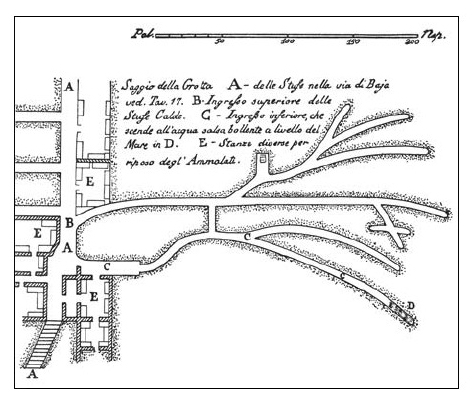
8 | Agnano, plan of the Stoves of Nero, where rooms connected to underground passages for capturing hot vapours are noted (Pagano 1984, fig. 7).
The story of Vespasian and St Victorinus who died from the cold, sulfurous waters of Cittaducale brings us back to consider, as we turn to the conclusion, the organizational logistics that underpinned the management of ancient healing facilities. If the articulation of pools with hot or cold water was closely linked to the presence of the spring, the latter was often monumentalised, as is well shown in the case of the Aquae Tauri: in this case it served basins of different widths and probably at different temperatures (Köhler 1999; Ghedini, Bassani 2014, esp. 268), around which were located, as at Cutiliae and as in so many other cases, compartments with various purposes. Ancient literary sources record that the aquae were staffed by medical personnel, who operated in rooms used as “clinic rooms” where the sick could be examined before, during, and at the end of the thermo-mineral treatment. But there were also staff we would nowadays call ‘paramedic’, such as specialised masseurs, called unctores and iatraliptes, who treated body parts using oils and ointments (see, e.g., Cels. 1, 1, 1), but also fricatores and tractatores, who were in charge of frictions (see, e.g., Cael. Aur. chron. 3, 7, 92). These were mostly of servile extraction, but we infer from the texts that they had specific expertise within the spas (as well as in the hygienic baths), and their services involved a wide range of activities, in which mineral water, salts and mud were mixed in liquid solutions or in creamy versions, to be applied on patients lying on beds or in individual tubs: this must have been the purpose of the many rooms surrounding the pools so frequently found in Roman healing stations.
These were probably the rooms that ancient sources call cubicola diurna open on the peristyle and courtyards, such as those at Aquae Tauri ([Fig. 7]: Turchetti 1999, in partic. 60) but also at Montegrotto Terme, in the spa of Via Scavi (see the small rooms between the baths, perhaps connected to a gymnasium in front: Bonomi, Malacrino 2012, esp. 167-168). To the cubicula should be added the rooms used for hydro-pinic therapy, where patients stayed on seats to drink, as in the case of Cutiliae. Again, in some rooms equipped with drainage ducts, irrigation and washing could be carried out, nor can it be excluded that in some cases showers and inhalations were performed; there was evidently no shortage of latrines either, of which no less than five have been identified at Aquae Tauri (Köhler 2011, 121-122).
About the presence of spouts from which jets of thermo-mineral water for showers came out, one may recall the lead pipes discovered in the pillars surrounding the thermal pool at Aquae Caeretanae, in Latium, whose source is at 40°C with a high sulfur component (Turchetti 1999, 69). These tubes had an inclination opposite to the planes of the pool, which allowed the jet to fall with a fountain effect, under which patrons evidently placed themselves with their whole body or just the parts to be treated. When the therapy was over, they could then stand in the adjacent rooms, three of which have been brought to light and which look like rooms for resting and siestas: they had frescoed walls and mosaic floors, facing a courtyard. In the more complex and articulated healing stations, such as the Aquae Tauri, there were also rooms for reading: the large room 51 overlooking the uncovered space in front has been interpreted as a probable library, due to the presence of rectangular niches necessary for the placement of shelves. As for inhalation by steam, however, the most relevant evidence from the Roman period is found in the Baian installations, particularly in the Stufe di Nerone/Sudatorio di Tritoli (Pagano 1984, esp. 155-168). Here on several occasions long conduits dug into the rock were found, which allowed the flow of hot air, to be used for heat baths (the laconica or sudationes) or for inhalation [Fig. 8], to be brought into the rooms built by incision of the yellow tuffaceous bank of the hill.

9 | Pesaro, Museo Oliveriano, photos of some anatomical votive offerings from the Lucus Pisaurensis, including a mask, human hands and feet as well as mono- and biungulate animal legs (Di Luca 2004, 27, fig. 32) (By permission of the Ministry of Culture – Soprintendenza Archeologia, Belle Arti e Paesaggio per l’area metropolitana di Venezia e le province di Belluno, Padova e Treviso – Reproduction forbidden).
10 | The base with the ode in honor of the Aquae Albulae for the healing of the horse Samis (Paci 2006, fig. 6) (By permission of the Ministry of Culture – Soprintendenza Archeologia, Belle Arti e Paesaggio per l’area metropolitana di Venezia e le province di Belluno, Padova e Treviso – Reproduction forbidden).
Sources also tell us of spas where people could be entertained through recitations and performances designed to amuse the patients. In Montegrotto Terme at the large baths, there was actually a small theater (Bonomi, Malacrino 2011), where plays, compositions, and musical performances could be attended by the sick and the pilgrims between treatments. Only one other example of a performance building connected to healing stations in Roman Italy is known, in the water city of Acqui Terme, but it is possible that non-permanent wooden structures were provided in many other contexts as well, to cheer the stay of pilgrims and wayfarers who stopped at the Aquae (Bassani 2017). Indeed, the presence of multiple residences discovered around the main mineral springs confirms that there was extensive development of accommodation facilities of various social levels, attested in Italy and in many contexts of the empire (Annibaletto 2014, esp. 102-104).
And precisely because the user base was diversified, the possibilities of making use of those special waters must also have been varied, useful for humans but also for animals, at least for those needed for the family property and essential for the maintenance of the satellite activities for their derivatives. I have already offered several observations on this aspect, to which I would like to refer (Bassani 2011; Bassani 2012). Thermal therapies could involve both baths in special pools of water and mud baths, according to a practice that the Romans certainly knew and used, as inferred from a passage by Pliny the Elder:
utuntur et caeno fontium ipsorum utiliter, sed ita si inlitum solem inarescat (Plin. nat. XXXI, 2, 32).
Mud from medicinal springs is also used with advantage, but the application must be sun-dried (Plin. nat. XXXI, 2, 32).
In fact, domestic animals were also taken to the Aquae, primarily those that were bred, as is evident from the analysis of ex-votos recovered at various surveyed thermo-mineral sites in Italy, which could refer not only to a generic sacrifice but also to a request for protection toward the animals themselves: from Veneto to Emilia, from Marche to Lazio to Campania and probably also in Sicily, there are clues to ‘veterinary’ care as early as the Archaic age.
In the cases examined, it emerged how votive offerings could include not only horses and oxen, which were considered then as now to be precious animals of great economic value, but also sheep, thus apparently less valuable livestock. The presence of statuettes of sheep and goats testifies to the importance also attributed to these animals in the ancient economy, which based much of its fortune on the trade of different types of wool: after all, flock farmers today confirm how important it is to avoid the spread of mycosis and parasitic forms among sheep precisely by bathing in thermal lakes, distributed in central Italy but also in other European locations. Near Pesaro, for example, in the shrine known as Lucus Pisaurensis (Di Luca 2004), very explicit anatomical votive offerings have been found, since they are in the shape of monungulate legs (so horses) and biungulate (oxen, sheep and pigs) that clearly represent the healed parts of sick animals [Fig. 9]. But the most important evidence of this practice is found in the discovery at the Aquae Albulae near Tivoli of a very interesting inscribed base, which bears a hexameter poem in honor of the Aquae Albulae and is dated to the Hadrianic age [Fig. 10]: the aquae had healed the horse Samis of which a statue was placed over the base, now lost but whose footprints remain. The animal had been wounded by a wild boar during a hunting trip near Roselle, and only thanks to the healing properties of those springs was Samis then able to make a full recovery (CIL XIV, 3911=Inscr. It. IV, 1, no. 596; reread in AE 2000, no. 380: Gascou, Janon 2000). The thanks of the horse’s owner could not have been more evident, and indeed in the inscription the dedicator specifies that the gift had been placed in such a way as to be visible from Hadrian’s Villa, in the direction of the Sanctuary of Tivoli: and since, as is well known, this residence had been conceived and planned by Hadrian, there has been no lack of scholars who have proposed that the dedicatee of the ex voto was the emperor himself, or someone very close to him.
The base of the Samis horse statue from Tivoli thus suggests that at the Aquae Albulae there were not only healing buildings for humans, but presumably also separate areas for animals, which, then as now, could heal skin diseases or wounds by water immersions or mud applications. This practice also had a long tradition in the post-antique age precisely in the Veneto region, as clarified both by a note by the physician Gabriele Falloppio in his 1564 De medicatis aquis, which mentions a “balneum equorum, eo quod soleant equos in ipsum immergere”, and a 1793 map by Salvatore Mandruzzato, which in the Euganean area indicated the presence of pools for animals and specifically for horses ([Fig. 11, no. 11] “Horse bath”). In Montegrotto, then, tradition records that free thermal water pools for equine bathing were attached to the Hotel Vulcania in the last century.
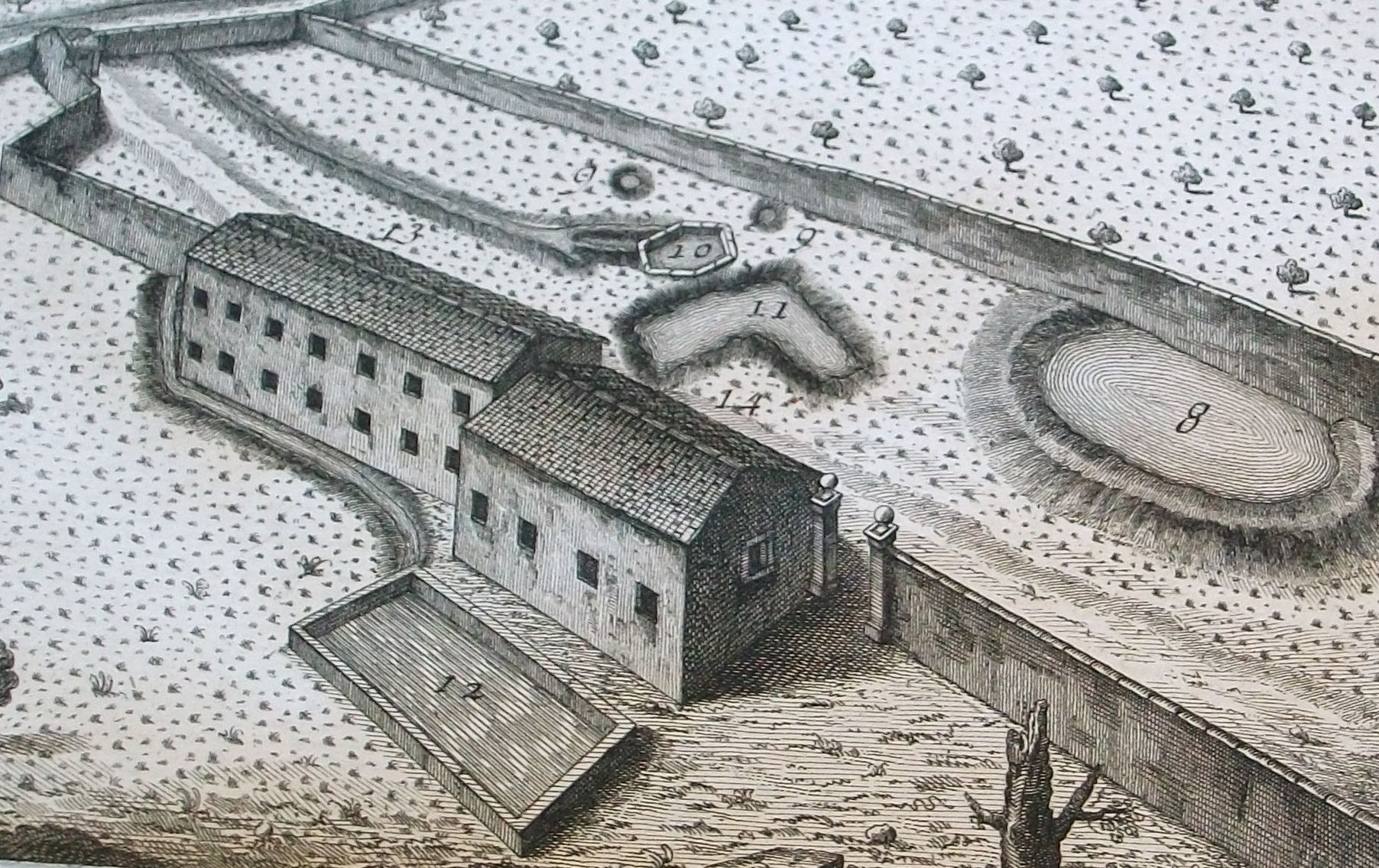
11 | Map showing some buildings and thermo-mineral water springs for use in horse baths near Monteortone, between Abano and Montegrotto Terme (Mandruzzato 1793, Plan I).
The importance of having healthy animals did not only respond to economic demands, but was also, and perhaps above all, a matter of collective well-being. In societies in which humans shared the same spaces with animals, it was essential to avoid the transmission of diseases by contact, such as certain mycoses or other skin diseases such as rabies (animal) or scabies (human), not to mention other parasites (lice, ticks, fleas). This emerges well from the Carmen Lustrale transmitted by Cato where the dedicator of a suovetaurile addresses Mars to protect not only his family and home, but also the fields and livestock, and asks in particular that the flocks be kept safe and sound:
Mars pater te precor quaesoque
uti sies volens propitius
mihi domo familiaeque nostrae.
Quoius rei ergo
agrum terram fundumque meum
suovitaurilia circumagi iussi,
uti tu morbos visos invisosque
viduertatem vastitudinemque,
calamitates intemperiasque
prohibessis defendas averruncesque,
utiques tu fruges frumenta,
vineta virgultaque,
grandire beneque evenire siris,
pastores pecuaque
salva servassis,
duisque bonam salutem valetudinemque
mihi domo familiaeque nostrae:
harunce rerum ergo,
fundi terrae agrique mei lustrandi
lustrique faciendi ergo,
sicuti dixi,
macte hisce suovitaurilibus
lactentibus inmolandis esto.
O Father Mars
I pray and beseech thee,
that you may be favorable and propitious
To me to the house and to our family.
And for this grace
Around my field,
my land and my fund a swine,
a ram and a bull I have caused to be led
For thou the visible and invisible evils
the doom and devastation
calamity and inclement weather
Thou shalt prevent, drive out and drive away,
and that the harvests,
the grain, the vineyards and the saplings,
you let them grow well and develop,
and the shepherds and flocks
keep them safe and sound,
and good health and prosperity thou givest
To me and to my house and family:
Therefore, for these things,
to purify the bottom, the earth and my field,
to obtain purification,
as I said,
be honored with the sacrifice
Of this swine, of this ram, and of this bull that is still suckling (Cato agr. 141, 2-3).
The large-scale scope of this phenomenon can also be discerned in the Campanian shrine at Mount Tifata in the vicinity of Capua and dedicated to Diana, which was frequented from the Republican age until the late Imperial age. As I have had the opportunity to propose (Bassani 2014a, esp. 155-160), it is possible that here Hannibal, after defeating the Romans at Canne in 216 BC, chose to have his army stop not only for strategic reasons in order to better control the territory, the sanctuary being on a hill that allowed the view of the entire surrounding plain [Fig. 12], but also because there were precious sulfurous waters supervised by Diana, suitable for healing the wounds of soldiers and animals. Her attention to the equine component is conveyed to us by Polybius, who mentions in no less than two passages treatments to counteract diseases occurring to men and animals:
(1)ἐν ᾧ καιρῷ καταστρατοπεδεύσας παρὰ τὸν Ἀδρίαν ἐν χώρᾳ πρὸς πάντα τὰ γεννήματα διαφερούσῃ μεγάλην ἐποιεῖτο σπουδὴν ὑπὲρ τῆς ἀναλήψεως καὶ θεραπείας τῶν ἀνδρῶν, οὐχ ἧττον δὲ καὶ τῶν ἵππων.(2) ὡς ἂν γὰρ ὑπαίθρου τῆς παραχειμασίας γεγενημένης ἐν τοῖς κατὰ Γαλατίαν τόποις, ὑπό τε τοῦ ψύχους καὶ τῆς ἀνηλειψίας, ἔτι δὲ τῆς μετὰ ταῦτα διὰ τῶν ἑλῶν πορείας καὶ ταλαιπωρίας ἐπεγεγόνει σχεδὸν ἅπασι τοῖς ἵπποις, ὁμοίως δὲ καὶ τοῖς ἀνδράσιν ὁ λεγόμενος λιμόψωρος καὶ τοιαύτη καχεξία. (3) διὸ γενόμενος ἐγκρατὴς χώρας εὐδαίμονος ἐσωματοποίησε μὲν τοὺς ἵππους, ἀνεκτήσατο δὲ τά τε σώματα καὶ τὰς ψυχὰς τῶν στρατιωτῶν: μετακαθώπλισε δὲ τοὺς Λίβυας εἰς τὸν Ῥωμαϊκὸν τρόπον ἐκλεκτοῖς ὅπλοις, ὡς ἂν γεγονὼς κύριος τοσούτων σκύλων (Polyb. III, 87, 1-3).
(1) Pitching his camp on the shore of the Adriatic, in a district extraordinarily rich in every kind of produce, he took great pains to refresh his men and restore their health, and no less so that of the horses. (2) For the cold and squalor of a winter spent in Gallia Cisalpina without the protection of a roof, and then the painful march through the marshes, had brought upon most of the horses, and the men as well, an attack of scurvy and all its consequences. (3) Having therefore now got possession of a rich country, he got his horses into condition again, and restored the bodies and spirits of his soldiers; and made the Libyans change their own for Roman arms selected for the purpose, which he could easily do from being possessed of so many sets stripped from the bodies of the enemy (Polyb. III, 87, 1-3).
Again, Polybius informs us that:
Ἀννίβας δὲ κατὰ βραχὺ μεταθεὶς τὴν παρεμβολὴν ἐνδιέτριβε τῇ παρὰ τὸν Ἀδρίαν χώρᾳ καὶ τοὺς μὲν ἵππους ἐκλούων τοῖς παλαιοῖς οἴνοις διὰ τὸ πλῆθος ἐξεθεράπευσε τὴν καχεξίαν αὐτῶν καὶ τὴν ψώραν, παραπλησίως δὲ καὶ τῶν ἀνδρῶν τοὺς μὲν τραυματίας ἐξυγίασε, τοὺς δὲ λοιποὺς εὐέκτας παρεσκεύασε καὶ προθύμους εἰς τὰς ἐπιφερομένας χρείας (Polyb. III, 88, 1).
Though Hannibal shifted his quarters from time to time for short distances in one direction or another, he remained in the neighbourhood of the Adriatic; and by bathing his horses with old wine, of which he had a great store, cured them of the scab and got them into condition again. By a similar treatment he cured his men of their wounds and got the others into a sound state of health and spirits for the service before them (Polyb. III, 88, 1).
It is no coincidence that the Tabula Peutingeriana records the location of a site called Castra An(n)iba(lis) near both the river and shrines in honor of Diana and Jupiter, as well as probable baths traceable back to Silla (Syllas), and still in the mid-nineteenth century we hear of bathing practices for horses at the same springs. Giuseppe Novi, in his 1886 work devoted to the construction of a bathing complex on the slopes of Mount Tifata to exploit the medicinal waters, envisioned the construction of a pool for healthy horses separated by means of the Volturno River from a second pool for sick horses, in order to treat their sores and other skin diseases (Bassani 2014a, 157 and footnote 73 [Fig. 13]).
In conclusion, then, the study of thermalism in ancient times allows us to understand the dynamics of the use of aquae not only to ensure ad hoc therapies and comforts of various kinds for humans, but also to provide for the health and healing of their animals, in a perspective of general social and economic well-being that was maintained over the centuries without interruption.
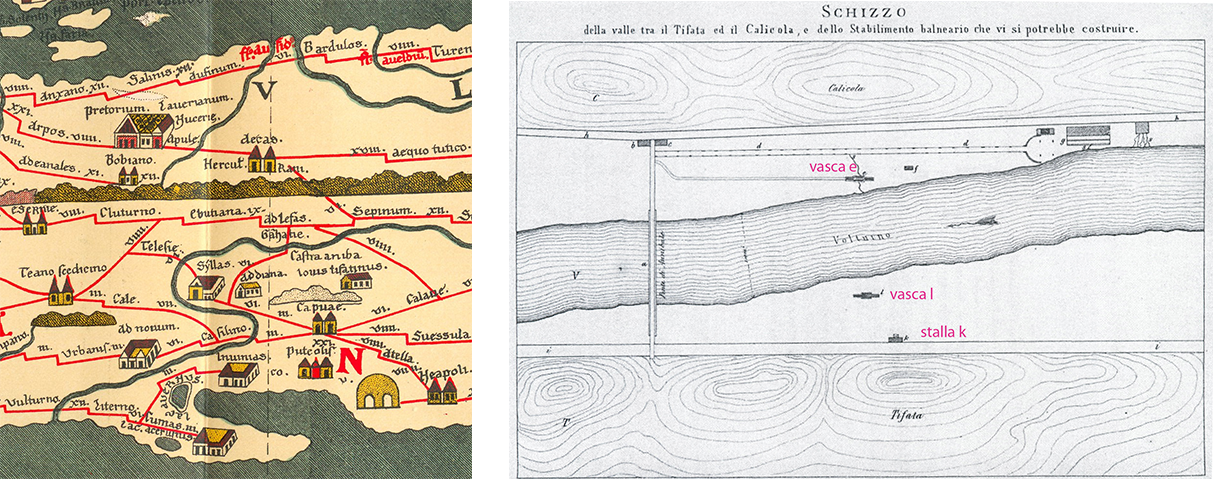
12 | Sant’Angelo in Formis (Capua), the area of the Tifata Mountain in the Tabula Peutingeriana, segment VI (Omnes Viae).
13 | Plan sketch by Giuseppe Novi showing the curative buildings to be constructed at the Tifata springs, including pools and stables for horses (Novi [1886] 1979, 257).
Bibliography
- Alvino 2009
G. Alvino, I santuari, in Coarelli, De Santis 2009, 97-103. - Annibaletto 2014
M. Annibaletto, Le stazioni termominerali: tipologie architettoniche e sistemi infrastrutturali, in Annibaletto, Bassani, Ghedini 2014, 129-142. - Annibaletto, Basso 2014
M. Annibaletto, P. Basso, Tra uomo e natura: insediamenti e paesaggi termali, in Annibaletto, Bassani, Ghedini 2014, 73-108. - Annibaletto, Bassani, Ghedini 2014
M. Annibaletto, M. Bassani, F. Ghedini (a cura di), Cura, preghiera e benessere. Le stazioni curative termominerali nell'Italia romana, Padova 2014. - Bassani A. 2014
A. Bassani, Note idrotermali: caratterizzazione, prodotti, usi diversi, in Annibaletto, Bassani, Ghedini 2014, 29-43. - Bassani 2011
M. Bassani, Le terme, le mandrie e Gerione: nuove ipotesi per l’area euganea, in Bassani, Bressan, Ghedini 2011, 223-243. - Bassani 2012
M. Bassani, Greggi e mandrie fra termalismo e profezia, “Gerión” 30 (2012), 185-208. - Bassani 2014a
M. Bassani, I santuari e i luoghi di culto presso le sorgenti termominerali, in Annibaletto, Bassani, Ghedini 2014, 143-160. - Bassani 2014b
M. Bassani, Per una carta distributiva degli spazi sacri alle fonti curative, in Annibaletto, Bassani, Ghedini 2014, 161-188. - Bassani 2016
M. Bassani, Soltanto 'salus per aquam'? Utilizzi non terapeutici delle acque termominerali nell'Italia romana, in J. Bonetto, M.S. Busana, A.R. Ghiotto, M. Salvadori, P. Zanovello (a cura di), I mille volti del passato. Studi in onore di Francesca Ghedini, Roma 2016, 879-891. - Bassani 2017
M. Bassani, Le acque termominerali nell'Italia antica fra pellegrinaggi e svaghi, in G. Belli, F. Capano e M.I. Pascariello (a cura di), La città, il viaggio, il turismo. Percezione, produzione e trasformazione, Atti Convegno Internazionale AISU (Napoli, 7-9 settembre 2017), Napoli 2017, 607-614. - Bassani 2019
M. Bassani, Shrines and Healing Waters in Ancient Italy. Buildings, Cults, Deities, in Bassani, Bolder-Boos, Fusco 2019, 9-20. - Bassani 2021
M. Bassani, Beyond health. The exploitation of thermomineral sources in artisan activities, in D. Van Limbergen, D. Taelman (eds.), Archaeology and Economy in the Ancient World, Proceedings of the 19th International Congress of the Classical Archaeology (AIAC: Panel 4.4, Archaeology and Economy in the Ancient World 27), Heidelberg 2021, 79-98. - Bassani, Bolder-Boos, Fusco 2019
M. Bassani, M. Bolder-Boos, U. Fusco (eds.), Rethinking the Concept of 'Healing Settlements', Cults, Constructions and Contexts close to springs in the Ancient World, Oxford 2019. - Bassani, Bressan, Ghedini 2011
M. Bassani, M. Bressan, F. Ghedini (a cura di), Aquae patavinae. Il termalismo antico nel comprensorio euganeo e in Italia, Atti del I Convegno Nazionale (Padova, 21-22 giugno 2010), Padova 2011. - Bassani, Bressan, Ghedini 2012
M. Bassani, M. Bressan, F. Ghedini (a cura di), Aquae patavinae. Montegrotto Terme e il termalismo in Italia. Aggiornamenti e nuove prospettive di valorizzazione, Atti del II Convegno Nazionale (Padova, 14-15 giugno 2011), Padova 2012. - Bassani, Bressan, Ghedini 2013
M. Bassani, M. Bressan, F. Ghedini (a cura di), Aquae salutiferae. Il termalismo fra antico e contemporaneo, Atti del Convegno Internazionale (Montegrotto Terme, 6-8 settembre 2012), Padova 2013. - Basso, Fanini 2016
P. Basso, E. Zanini (a cura di), Statio amoena. Sostare e vivere lungo le strade romane, Oxford 2016. - Bellini 2004
G.R. Bellini, Il santuario di Casale Pescarolo in Valle di Comino, in B. Rémy, F. Ballet, E. Ferber (a cura di), Religio: santuari ed ex voto nel Lazio meridionale, Atti della Giornata di studio (Terracina, 7 ottobre 2000), Terracina 2004, 95-107. - Bonomi, Malacrino 2011
S. Bonomi, C.G. Malacrino, L’edificio per spettacoli di Fons Aponi. Considerazioni a margine dei rilievi effettuati nell’area archeologica di viale Stazione/via degli Scavi, in Bassani, Bressan, Ghedini 2011, 29-55. - Bonomi, Malacrino 2012
S. Bonomi, C.G. Malacrino, Il complesso termale di viale Stazione/via degli Scavi, in Bassani, Bressan, Ghedini 2012, 155-191. - Borriello, D’Ambrosio 1979
M. Borriello, A. D’Ambrosio, Baiae-Misenum, Forma Italiae, Regio I, 14, Firenze 1979. - Caminneci 2014
V. Caminneci, Ad Aquas. Historical sources and archaeological evidence about Sciacca's thermalism in antiquity, in D. Gullì (ed.), From Cave to Dolmen. Ritual and symbolic aspects in the prehistory between Sciacca, Sicilia and the central Mediterranean, Oxford 2014, pp. 59-64. - Coarelli, De Santis 2009
F. Coarelli, A. De Santis (a cura di), Reate e l’ager reatinus. Vespasiano e la Sabina: dalle origini all’impero, Catalogo della Mostra (Rieti, 8 maggio-22 novembre 2009), Roma 2009. - Di Luca 2004
M.T. Di Luca (a cura di), Il lucus Pisaurensis, Pesaro 2004. - Dämmer 1987
H.-W. Dämmer (a cura di), San Pietro Montagnon (Montegrotto). Un santuario protostorico lacustre nel Veneto, Mainz am Rhein 1987. - De Cazanove, Scheid 2003
O. de Cazanove, J. Scheid (éds.), Sanctuaires et sources dans l’antiquité. Les sources documentaires et leurs limites dans la description des lieux de culte, Actes de la table ronde (Naples, 30 novembre 2001), Napoli 2003. - Gascou, Janon 2000
J. Gascou, M. Janon, Les chevaux d’Hadrien, “Revue archéologique de Narbonnaise” 33 (2000), 61-68. - Gasperini 2006
L. Gasperini (a cura di), Usus veneratioque fontium. Fruizione e culto delle acque salutari nell'Italia romana, Atti del Convegno Internazionale di Studio (Roma-Viterbo, 29-31 ottobre 1993), a cura di L. Gasperini, Tivoli 2006. - Ghedini 2014
F. Ghedini, Le acque termali nella toponomastica antica: fonti itinerarie, letterarie ed epigrafiche, in Annibaletto, Bassani, Ghedini 2014, 73-108. - Ghedini, Bassani 2014
F. Ghedini, M. Bassani, Risultati e prospettive, in Annibaletto, Bassani, Ghedini 2014, 263-280. - Ghedini et alii 2015
F. Ghedini, P. Zanovello, M. Bassani, C. Destro, M.T. Privitera, M. Bressan, La Villa di via Neroniana (Montegrotto Terme - Padova). Fra conoscenza e valorizzazione, “Amoenitas”, IV (2015), 11-40. - González Soutelo forthcoming
S. González Soutelo (ed.), Ancient Thermalism. Thermal spas and territory: the role of mineral-medicinal waters in the Roman provinces, Proceedings of the 3rd International Congress (Madrid, Universidad Autonoma de Madrid, 9th-10th May 2023), forthcoming. - Guérin-Beauvois, Martin 2007
M. Guérin-Beauvois, J.M. Martin (éds.), Bains curatifs et bains hygiéniques en Italie de l'antiquité au Moyen Âge, Roma 2007. - Guidi, Verde 2001
P. Guidi, G. Verde, Il fenomeno carsico del monte Cronio (e). Saggio Bibliografico, Atti e Memorie della Commissione Grotte ‘E. Boegan’, suppl. 24, Trieste 2001. - Gullì 2014
D. Gullì, The prehistory of Sciacca between old acquisitions and new research, in D. Gullì (ed.), From Cave to Dolmen. Ritual and symbolic aspects in the prehistory between Sciacca, Sicily and the central Mediterranean, Oxford 2014, 9-29. - Köhler 1999
J. Köhler, Die Terme Taurine bei Civitavecchia, Publikationsstand - Chronologie – Bibliothek, “Römische Mitteilungen” 106 (1999), 365-376. - Köhler 2011
J. Köhler, Toilets in Roman Spa Baths: The Taurine baths, in G.C.M. Jansen, A.O. Koloski-Ostrow, E.M. Moormann (eds.), Roman Toilets. Their Archaeology and Cultural History, “BABesch” suppl. 19 (2011), 121-122. - Maggi 1976-1977
R. Maggi, Gli scavi delle stufe di San Calogero sul Monte Kronio (Sciacca) e i rapporti fra la Sicilia e Malta durante il Neolitico, “Kokalos” XXII-XXIII (1976-1977), 510-518. - Madruzzato 1793
S. Mandruzzato, Dei bagni di Abano, Padova 1789-1804, voll. I-III. - Mannoni 1975
T. Mannoni, Saggi di scavo nei livelli medievali delle ‘Stufe di S. Calogero’ (Sciacca), “Archeologia medievale” II (1975), 389-392. - Mareri 1982
F.V. Mareri, La storia di Cotilia in Sabina, s.l.1982. - Marinelli 2003
R. Marinelli, S. Michele Arcangelo, la basilica delle acque, Rieti 2003. - Matilla Séiquer, González 2017
G. Matilla Séiquer, S. Gónzalez Soutelo (eds.), Termalismo antiguo en Hispania. Un análisis del tejido balneario en época romana y tardorromana en la península ibérica, «Anejos de Archivo Español de Arqueología» LXX, Madrid 2017. - Medri 2013
M. Medri, In baiano sinu: il vapor, le aquae e le piccole terme di Baia, in Bassani, Bressan, Ghedini 2013, 119-144. - Medri 2016
M. Medri, Lavarsi in viaggio e in albergo: alcune osservazioni sui balnea per i viaggiatori, in Basso, Zanini 2016, 91-110. - Novi [1886] 1979
G. Novi, Delle acque minerali dei monti Palombara e Tifata e dell’utilità d’una stazione balnearia presso al Ponte di Annibale, Memoria letta all’Accademia Pontaniana nella tornata del 22 giugno 1884, Napoli 1979 [1886]. - Paci 2006
G. Paci, Idroterapia e religiosità alle Aquae Albulae presso Tivoli, in Gasperini 2006, 255-275. - Pagano 1984
M. Pagano, Il lago Lucrino. Ricerche storiche e archeologiche, “Puteoli” 7-8 (1984), 113-226 - Perex Agorreta 1997
M.J. Perex Agorreta (ed.) Termalismo antiguo, Atti del 1 Congreso peninsular (Arnedillo, La Rioja, 3-5 octubre 1996), Madrid 1997. - Pérex Agorreta, Miró i Alaix 2018
M.J. Pérex Agorreta, C. Miró i Alaix, Ubi aquae ibi salus. Aguas mineromedicinales, termas curativas y culto a las aguas en la península ibérica (desde la Protohistoria a la Tardoantigüedad), Madrid 2018. - Rizzi 2014
A. Rizzi, Acque e cure termali nel mondo antico, in Annibaletto, Bassani, Ghedini 2014, 65-72. - Sapelli Ragni, Mari 2011
M. Sapelli Ragni, Z. Mari, Il termalismo terapeutico antico nel Lazio: stato della ricerca ed esemplificazioni, in Bassani, Bressan, Ghedini 2011, 286-287. - Thermes romains 1991
Les thermes romains, “Actes de la table ronde organisée par l’École française de Rome” (Rome, 11-12 novembre 1988), Roma 1991. - Tiné, Torelli 2013
V. Tiné, L. Torelli, Il complesso speleo-termale del Monte Kronio di Sciacca (AG) tra mitologia, speleologia e archeologia, in Bassani, Bressan, Ghedini 2013, 109-118. - Turchetti 1999
R. Turchetti, Aquae Ceretanae, in Termalismo antico e moderno nel Lazio, Regione Lazio, Assessorato Sviluppo Economico ed Attività Produttive, Roma 1999, 57-64; 68-72. - Verde 2000
G. Verde, Il termalismo di Sciacca dalla preistoria al XX secolo, Agrigento 2000. - Zanchin 2013
G. Zanchin, Le Terme Euganee. Cenni storici, in Bassani, Bressan, Ghedini 2013, 19-28. - Zanetti 2014
C. Zanetti, I luoghi del termalismo nelle parole degli antichi, in Annibaletto, Bassani, Ghedini 2014, 53-64.
The article discusses some aspects related to the exploitation of natural thermalism in Antiquity starting with an examination of pre-Roman and Roman contexts that were used for curative purposes over time, focusing on the Grotte del Kronio, in Sicily, and the Aquae Cutiliae, in Latium. These two sites are different from each other both in terms of the quality of the geo-thermal phenomenon and the type of settlements, but they also allow us to gather interesting elements on aspects related to the literary and cultural-historical tradition that developed around them over the centuries. Prospects for further study also open up to the consideration of the socio-economic consequences that the exploitation of mineral springs entailed for ancient societies, including veterinary care and the economic incentive resulting from the possession of healthy herds with high commercial potential.
keywords | Thermalism; Kronio; Cutiliae; Healing treatments.
questo numero di Engramma è a invito: la revisione dei saggi è stata affidata al comitato editoriale e all'international advisory board della rivista
Per citare questo articolo / To cite this article: M. Bassani, Healing with mineral waters. Places, objects and written sources in Roman Italy, “La Rivista di Engramma” n. 214, luglio 2024, 105-126 | PDF